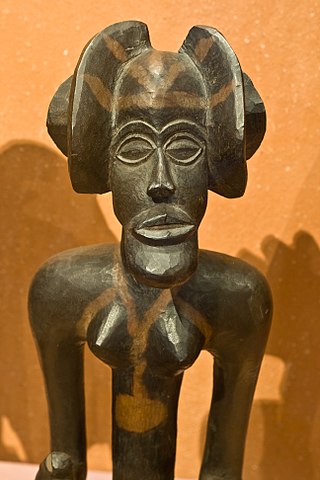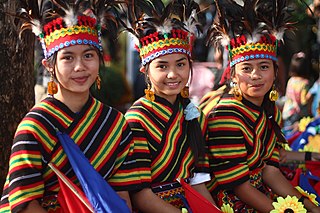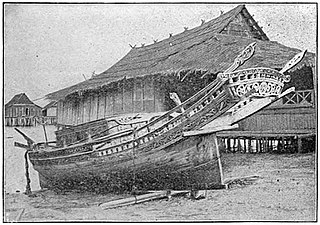
Totem poles are monumental carvings found in western Canada and the northwestern United States. They are a type of Northwest Coast art, consisting of poles, posts or pillars, carved with symbols or figures. They are usually made from large trees, mostly western red cedar, by First Nations and Indigenous peoples of the Pacific Northwest Coast including northern Northwest Coast Haida, Tlingit, and Tsimshian communities in Southeast Alaska and British Columbia, Kwakwaka'wakw and Nuu-chah-nulth communities in southern British Columbia, and the Coast Salish communities in Washington and British Columbia.

The culture of Indonesia has been shaped by long interaction between original indigenous customs and multiple foreign influences. Indonesia is centrally-located along ancient trading routes between the Far East, South Asia and the Middle East, resulting in many cultural practices being strongly influenced by a multitude of religions, including Buddhism, Christianity, Confucianism, Hinduism, and Islam, all strong in the major trading cities. The result is a complex cultural mixture, often different from the original indigenous cultures.
A gope board is a wooden ritual object made in the Papuan Gulf of New Guinea. Each board represents the spirit of an ancestral hero that can protect clans from evil spirits and death.

Okir, also spelled okil or ukkil, is the term for rectilinear and curvilinear plant-based designs and folk motifs that can be usually found among the Moro and Lumad people of the Southern Philippines, as well as parts of Sabah. It is particularly associated with the artwork of the Maranao and Sama (Badjao) tribes, although it can also be found to a lesser extent among the Maguindanao, Iranun, Tausug, Yakan, and Lumad groups. The design elements vary among these ethnic groups, with the greatest refinement being found among the Maranao.

The Chokwe people, known by many other names, are a Bantu ethnic group of Central and Southern Africa. They are found primarily in Angola, southwestern parts of the Democratic Republic of the Congo, and northwestern parts of Zambia.

The Asmat are an ethnic group of New Guinea, residing in the province of South Papua, Indonesia. The Asmat inhabit a region on the island's southwestern coast bordering the Arafura Sea, with lands totaling approximately 18,000 km2 (7,336 mi2) and consisting of mangrove, tidal swamp, freshwater swamp, and lowland rainforest.

The vinta is a traditional outrigger boat from the Philippine island of Mindanao. The boats are made by Sama-Bajau, Tausug and Yakan peoples living in the Sulu Archipelago, Zamboanga peninsula, and southern Mindanao. Vinta are characterized by their colorful rectangular lug sails (bukay) and bifurcated prows and sterns, which resemble the gaping mouth of a crocodile. Vinta are used as fishing vessels, cargo ships, and houseboats. Smaller undecorated versions of the vinta used for fishing are known as tondaan.
The Papuans are one of four major cultural groups of Papua New Guinea. The majority of the population lives in rural areas. In isolated areas there remains a handful of the giant communal structures that previously housed the whole male population, with a circling cluster of huts for the women. The Papuan people are Melanesian people composed of at least 240 different peoples, each with its own language and culture. Sago is the staple food of the Papuan supplemented with hunting, fishing and small gardens.

Hopi katsina figures, also known as kachina dolls, are figures carved, typically from cottonwood root, by Hopi people to instruct young girls and new brides about katsinas or katsinam, the immortal beings that bring rain, control other aspects of the natural world and society, and act as messengers between humans and the spirit world.

The Beembe are a Bantu people living in southern Congo-Brazzaville, precisely in Bouenza and in the cities of Brazzaville, Dolisie, and Pointe-Noire. It is a Kongo subgroup. The Beembe have some similar customs to the Kongo, which is what makes them a subgroup, but their art is what separates them apart. It is not clear when the Beembe separated from the Kongo but oral tradition suggests that it was some time around the eight century. They migrated Northeast from the Kongo and settled some five hundred kilometers from the capital of the Kingdom of the Kongo. This group was a part of the Kongo Kingdom during its height of power. The Beembe also have subgroups within it such as the Bisi-Nseke, Minkegue, Mmsumbu (Bambumbu), the Mongo, and the Musitu.Beembe society is economically based on agriculture.

The Ifugao people are the ethnic group inhabiting Ifugao province in the Philippines. They reside in the municipalities of Lagawe, Aguinaldo, Alfonso Lista, Asipulo, Banaue, Hingyon, Hungduan, Kiangan, Lamut, Mayoyao, and Tinoc. The province is one of the smallest provinces in the Philippines with an area of only 251,778 hectares, or about 0.8% of the total Philippine land area. As of 1995, the population of the Ifugaos was counted to be 131,635. Although the majority of them are still in Ifugao province, some of them have moved to Baguio, where they work as woodcarvers, and to other parts of the Cordillera Region.

Kwakwaka'wakw art describes the art of the Kwakwaka'wakw peoples of British Columbia. It encompasses a wide variety of woodcarving, sculpture, painting, weaving and dance. Kwakwaka'wakw arts are exemplified in totem poles, masks, wooden carvings, jewelry and woven blankets. Visual arts are defined by simplicity, realism, and artistic emphasis. Dances are observed in the many rituals and ceremonies in Kwakwaka'wakw culture. Much of what is known about Kwakwaka'wakw art comes from oral history, archeological finds in the 19th century, inherited objects, and devoted artists educated in Kwakwaka'wakw traditions.

Kulap figurines of limestone or chalk were made in Melanesia. The small funerary sculptures from New Ireland were associated with death rituals. They are typical in the hilly Punam region of the New Ireland province in Papua New Guinea of the Bismarck Archipelago. They were believed to contain the soul of the deceased person whom they were meant to represent, and would be ritually smashed once their usefulness or the period of mourning was over. In more recent years, some have been sold in their intact forms to Westerners, particularly to German administrators.

Bulul, also known as bul-ul or tinagtaggu, is a carved wooden figure used to guard the rice crop by the Ifugao peoples of northern Luzon.
Wood carving is a common art form in the Cook Islands. Sculpture in stone is much rarer although there are some excellent carvings in basalt by Mike Tavioni. The proximity of islands in the southern group helped produce a homogeneous style of carving but which had special developments in each island. Rarotonga is known for its fisherman's gods and staff-gods, Atiu for its wooden seats, Mitiaro, Mauke and Atiu for mace and slab gods and Mangaia for its ceremonial adzes. Most of the original wood carvings were either spirited away by early European collectors or were burned in large numbers by missionary zealots.
The name Makonde art refers to East African sculptures or, less frequently, to modern paintings created by craftspeople or artists belonging to the Makonde people of northern Mozambique and southern Tanzania, separated by the Ruvuma river. Art historians, dealers and collectors have created this genre of African art, that can be subdivided into African traditional artifacts or modern artistic works. This genre can be traced back to the 1930s, when the first documented exhibition of Makonde art was held at the Centro Cultural dos Novos in Mozambique.

Kundu is a pidgin name in Papua New Guinea for an hourglass drum used to accompany formal occasions, religious ceremonies and for celebrations. This drum is emblematic of Papua New Guinea and it appears on the country's coat of arms.

It is quite difficult to define Indonesian art, since the country is immensely diverse. The sprawling archipelago nation consists of 17.000 islands. Around 922 of those permanently inhabited, by over 1,300 ethnic groups, which speak more than 700 living languages.

The American Museum of Asmat Art is a gallery exhibiting the art and culture of the Asmat people of southwestern Papua, Indonesia, housed at the University of St. Thomas in St. Paul, Minnesota. Featuring more than 2,200 objects, it is one of the largest of its kind in the United States. Asmat art is widely collected in major Western museums despite the difficulty in visiting the remote region to collect work; the "exceptionally expressive" art "caused a sensation in art-collecting circles" which led to large-scale collecting expeditions in the post-WWII era, according to art scholar and ethnology Dirk A.M. Smidt. The gallery includes a permanent display of Asmat works such as ancestor poles (bis) and canoes, and a rotating exhibition highlighting aspects of Asmat art and culture. Much of the collection is accessible through the museum's online database.

Lepa, also known as lipa or lepa-lepa, are indigenous ships of the Sama-Bajau people in Indonesia, the Philippines, and Malaysia. They were traditionally used as houseboats by the seagoing Sama Dilaut. Since most Sama have abandoned exclusive sea-living, modern lepa are instead used as fishing boats and cargo vessels.


















